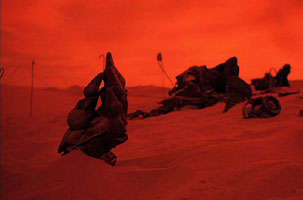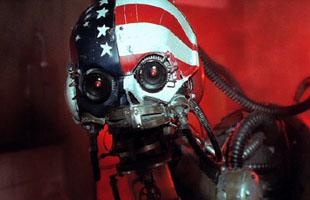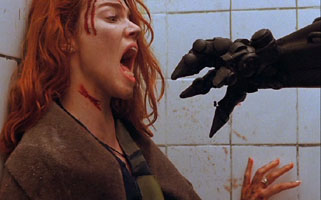In the not-too-distant future, pollution and nuclear war has turned the earth into a radioactive wasteland, where water is in short supply and much of the terrain has transformed in a post-apocalyptic, blood-red desert. A wanderer of these deserts scavenges bits and pieces of a disabled robot, including a head and hand. Looking to score some cash, he takes it to a junk merchant named Alvy and meets Moses Baxter, a soldier also looking to score some cash with Christmas right around the corner. Alvy is in the back when the scavenger arrives, and when Moses sees the stuff, he figures it would be the perfect gift for his tinkerer girlfriend Jill and buys it for himself. Upon taking it home, Jill makes a sculpture out of the parts unbeknownst that what they’re dealing with are scraps from a prototype MARK-13, a military droid programmed to kill  but abandoned before being put into production due to its erratic dependability. When Moses discovers Alvy dead at his shop and sees exactly what it is he’s bought for Jill, it may be too late; the MARK-13 has already begun to rebuild itself and is about to carry out its only directive: to kill.
but abandoned before being put into production due to its erratic dependability. When Moses discovers Alvy dead at his shop and sees exactly what it is he’s bought for Jill, it may be too late; the MARK-13 has already begun to rebuild itself and is about to carry out its only directive: to kill.
Taking inspiration from a short story called Shok! from the awesome UK comic series 2000AD (okay, so it was more like stealing and only called an inspiration after taking some trips through the legal system), Hardware is without a doubt one of the best sci-fi films of the 90’s. On a minuscule budget even at the time it was made, director Richard Stanley (who thankfully looks to finally be jumping back into the director’s chair) manages to create an alien world that rivals that of its big-budgeted cousins. It’s hard to create a plausible future universe that actually feels as if it could inevitably become reality in any sci-fi film, but Hardware achieves that in amazing fashion. Just the red haze that permeates throughout every corner of the frame gives the film an atmosphere that’s undeniable and something that seems like it could be scarily within reach; have you seen some of the images that have come from the wastelands and warzones of Afghanistan?
One of the coolest aspects of Hardware (next of the robot, which I’ll touch on later) is the fact that Stanley refuses to conform to sci-fi standards and makes the film something much more. A film about a dystopian future with killer robots isn’t exactly jumping up and down with originality, yet Hardware is unlike pretty much every other film in its genre. There’s loads of religious and political allegory sprinkled throughout, especially in the TV shows that we’re given a glimpse of occasionally, which ooze like propaganda from a totalitarian society. Stanley also plays a lot with genre conventions, twisting things to suit his own dark vision. Just like in real life, the good guys don’t always win. But it’s not that simple, as they aren’t exactly defeated either; deflated may be a better word.
The special effects and cinematography on display are quite impressive, especially when taking into consideration the scope of the idea and the pittance that was used to create it. Stanley reports that the film was basically shot 24/7 during the filming period with two different shifts, and the final result certainly shows that. Cinematographer Steven Chivers employs a lot of techniques we’re more familiar with seeing in Italian gialli than a sci-fi flick, including skewed camera angles, wild zooms, and amazing cornea close-ups. It’s not surprising then that Hardware, once the MARK-13 awakens and  all hell breaks loose in the apartment, takes on a more overt horror tone than you may initially expect. Likewise, there’s a hallucination sequence, that while some may argue is anticlimactic, that’s actually pretty damn unique and another element that sets Hardware apart from its like-minded brethren.
all hell breaks loose in the apartment, takes on a more overt horror tone than you may initially expect. Likewise, there’s a hallucination sequence, that while some may argue is anticlimactic, that’s actually pretty damn unique and another element that sets Hardware apart from its like-minded brethren.
And then there’s the MARK-13 itself, a wicked-looking abomination that almost echoes the entire spirit of Hardware. It’s made up of junk and scraps, it’s unrefined, and lacks the gloss that a high-tech killing machine should probably have. Yet it’s unstoppable, mean, and has spirit and personality to spare, just like the entire “against all odds” production of the film as a whole. I was honestly worried that finally being able to see a copy of Hardware that was actually pristine (more on that below) would pull back the curtain on some of the FX and shine too bright a light on their imperfections, but it’s actually quite the contrary. The MARK-13 never looks too fake, always look menacing, and if anything I’m now seeing even cooler things that were lost in the crap bootlegs that we’ve been served up with for years now.
Simply put, Hardware fucking rocks. It has a punk rock spirit that we just don’t see anymore, not just in sci-fi but filmmaking in general, and with so many things working against it you can’t help but root for the film, and it makes it all the more exhilarating that everything turns out as well as it does. It’s a shame that we’ll likely never see the awesome-sounding Hardware 2, but at least now we have the original archived in excellent quality, and we can run it back over and over again to our metal heart’s content. Although if the film’s tagline, “You Can’t Stop Progress” is to be believed, maybe we will get that sequel…or a Hardware-esque future reality. Until then, at least we can still consider this JUST entertainment.

After years of awful VHS copies and murky DVD bootlegs, Severin Films comes to the rescue of Hardware, releasing the film on both DVD and Blu-Ray, and the results are nothing short of revelatory. Both the DVD and Blu-Ray are presented in 1.85:1 anamorphic widescreen and look fantastic. Now maybe I’m just wowed at the fact that I can actually see every single thing that goes on in the apartment now once the lights go out, but I was dazzled by the quality, especially on the Blu-Ray. With so many reds and blues to deal with, the encode could have easily been problematic, but it looks strong, especially due to the high bitrate on both formats (the DVD is a 2-disc set, with just the film itself taking up most of the first DVD-9). Close-up shots are very well defined in both formats, with the Blu-Ray excelling when it comes to fine detail. The color is balanced very well, with flesh tones looking dead-on, even in the most red-drenched scenes. There is some print damage, but nothing that will ever distract. Both the DVD and the Blu-Ray sport audio in Dolby Digital 2.0 and 5.1 flavors (no uncompressed HD audio on the BR). I viewed the film in 5.1, and all dialogue is exceptionally clear with some great directionality and a booming soundtrack. Also included is a commentary track with director Richard Stanley and moderator Norman Hill. This is a great track for those that want to hear all the behind-the-scenes horror stories of working in the industry, as well as Stanley’s influences, fun with a drunken Lemmy from Motorhead, and more.
Now onto the extras, which on the DVD are all housed on disc 2 and on the Blu-Ray are all in wonderful 1080p. First up is “No Flesh Shall Be Spared”, a nearly hour-long documentary on the film, which includes interviews from Stanley, actress Stacey Travis, Lemmy, and a lot of members from the crew. You’ll get to see some killer pre-production artwork, some cool behind-the-scenes footage, and different perspectives and thoughts on the film. Next up is Incidents in an Expanding Universe, a 45-minute student film from Stanley that serves as a prequel to Hardware. While it certainly isn’t up to the same quality as the feature, it has a lot of the same ideas and characters and is definitely interesting. Two other Stanley short films, Rites of Passage (his first) and The Sea of Perdition (his latest) are also included and are both equally intriguing for fans. One of the coolest (and most melancholy for fans) extras is a seven-minute piece where Stanley discusses his ideas for the unproduced Hardware 2. It sounds great, and Stanley talks about how little things, such as Shade’s passing mention of going off-world in the first was included for the sole purpose of setting up the sequel. Stanley considers it a much better script than the first, and hopefully one day it’ll see the light of day. 25 minutes of deleted scenes are also included, and while they aren’t of the best quality, they do feature some interesting extended dialogue and action scenes. Rounding out the extras is a German trailer for the film as well as a vintage promo video. All told, this is one of the best cult releases of the year and a must own for genre fans.
*Please note that the screenshots on the left are not representative of the Blu-Ray and are taken from Severin's DVD release.
Please feel free to discuss "Hardware" here, in our forums!

